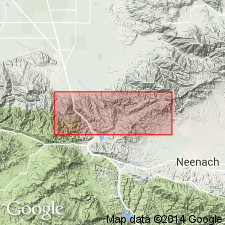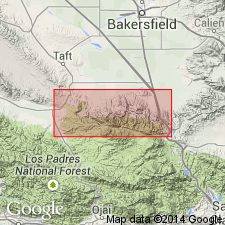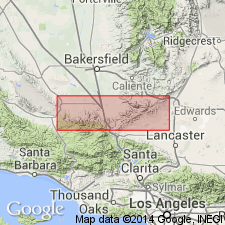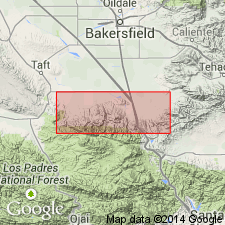
- Usage in publication:
-
- Uvas conglomerate member
- Modifications:
-
- Named
- Dominant lithology:
-
- Conglomerate
- AAPG geologic province:
-
- Transverse Ranges province
Summary:
Type locality designated as Grapevine Canyon, Tehachapi Mountains, Kern Co. [Bissell 7.5' quad], CA. Listed as basal member of the Tejon formation in type area of Tejon. Consists of 100 ft of fossiliferous conglomerate. Includes TUBULOSTIUM TEJONENSIS, ACTINOCYCLINA cf. ASTER, DISCOYCLINA sp. Conformably underlies the Liveoak member (new) (Tejon formation); unconformably overlies basement complex. Age is Eocene based on fossils [foraminifers].
Source: GNU records (USGS DDS-6; Menlo GNULEX).

- Usage in publication:
-
- Uvas Conglomerate Member*
- Modifications:
-
- Adopted
- AAPG geologic province:
-
- Transverse Ranges province
Summary:
Is thin (0 to 400 ft) discontinuous basal conglomerate and sandstone that rests unconformably on irregular erosion surface of pre-Tertiary basement complex. Contains locally abundant megafauna, boulder beds, breccias, and beach-type sandstones. Grades laterally eastward into the Tecuya Formation. Conformably underlies the Liveoak Shale Member (Tejon Formation). Age is Eocene.
Source: GNU records (USGS DDS-6; Menlo GNULEX).

- Usage in publication:
-
- Uvas Conglomerate Member*
- Modifications:
-
- Age modified
- AAPG geologic province:
-
- Transverse Ranges province
Summary:
Age is early and middle Eocene based on marine megafauna.
Source: GNU records (USGS DDS-6; Menlo GNULEX).

- Usage in publication:
-
- Uvas Conglomerate Member*
- Modifications:
-
- Overview
- AAPG geologic province:
-
- Transverse Ranges province
Summary:
Measured reference section designated as exposures on west side of Grapevine Creek, 1.75 mi south of Grapevine, S/2 sec. 29, T10N R19W, Grapevine 7.5' quad, Kern Co., CA. Thickness at type is 100.8 ft. Is progressively younger eastward ranging through "Domengine Stage" and "Transition Stage" to "Tejon Stage" east of Grapevine Creek. Age is early and middle Eocene.
Source: GNU records (USGS DDS-6; Menlo GNULEX).

- Usage in publication:
-
- Uvas Conglomerate Member*
- Modifications:
-
- Areal extent
- AAPG geologic province:
-
- California Coast Ranges province
Summary:
Geographically extended to area southeast of Jack Ranch fault near Gold Hill, Monterey Co., CA. Described as conglomerate, poorly exposed, cobbles, and boulders in float; best exposures in shallow stream cut at northeast end of map unit. Boulders consist predominantly of sandstone and hornblende quartz gabbro. Age is shown as Eocene.
Source: GNU records (USGS DDS-6; Menlo GNULEX).
For more information, please contact Nancy Stamm, Geologic Names Committee Secretary.
Asterisk (*) indicates published by U.S. Geological Survey authors.
"No current usage" (†) implies that a name has been abandoned or has fallen into disuse. Former usage and, if known, replacement name given in parentheses ( ).
Slash (/) indicates name conflicts with nomenclatural guidelines (CSN, 1933; ACSN, 1961, 1970; NACSN, 1983, 2005, 2021). May be explained within brackets ([ ]).

